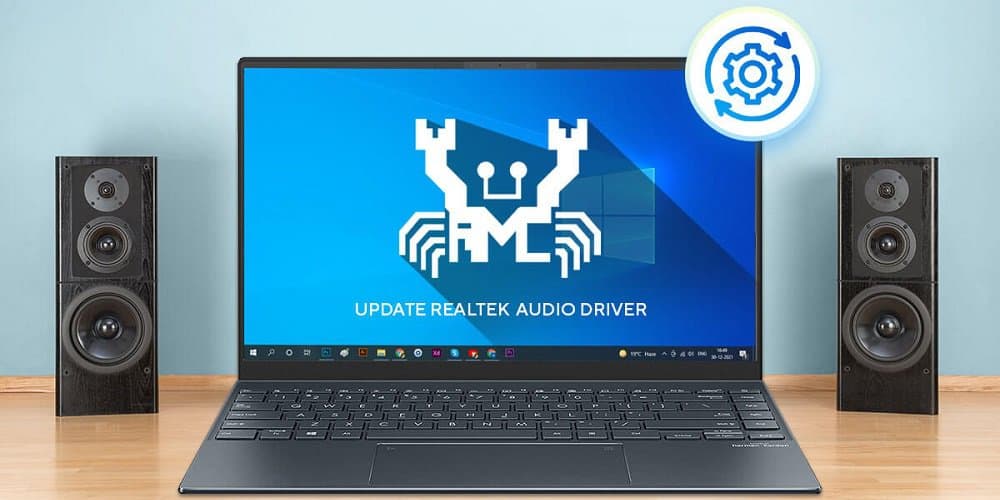
Realtek’s popular audio software requires the most recent HD Audio Drivers to work. The audio drivers allow your computer to communicate with your audio devices. Outdated drivers might cause sound quality problems, cutouts, or no sound. Continue reading to find out how to update the Realtek HD Audio Drivers on your Windows 11 or 10 computer.
How To Easily Update Realtek Audio Drivers In Windows 11?
It is extremely simple to update your Realtek audio drivers. You can check for updates, use the Device Manager to search for drivers, or download the files from the Realtek website. Well, to check for a Realtek Audio Driver update, follow the following steps:
1 – Select “Settings” from the “Start Menu” or by pressing “Windows + I.”
2 – Select “Windows Update” from the menu on the left.
3 – Choose the “Check for updates” option.
4 – Install update.
Well, here’s how to find the Realtek audio driver using the device manager’s automated search:
1 – Right-click “Start,” then select “Device Manager.”
2 – Open the “Audio inputs and outputs” option and afterward right-click “Speaker/Headphone (Realtek (R) Audio.”
3 – Select “Update Driver.”
4 – From the prompt, choose “Search automatically for drivers.”
5 – Wait for the latest Realtek audio drivers to be found. Then click “Install” to finish the installation.
6 – When the installation is finished, click “Close,” then restart your computer for the changes to take effect.
If the preceding technique fails to find the drivers, try downloading them from the Realtek website.
1 – Open a new web browser and navigate the HD Audio Codecs Software page.
2 – Locate the right driver for your system under the “Description” category, then click the “Download” button.
3 – Download the “High Definition Audio Codecs Software” if your system isn’t mentioned. You may also download the “AC’97 Audio Codecs Software” driver if you have an older system.
4 – Double-click the setup file and follow the on-screen steps to install the latest Realtek HD Audio Drivers after downloading the file.
How To Easily Update Realtek Audio Drivers In Windows 10?
In Windows 10, there are 3 ways to update your Realtek HD Audio Drivers. You may check for updates in Update & Security, use Device Manager’s Update Driver feature, or install the update directly from the Realtek website. To update the audio drivers via update status, follow these steps:
1 – Open “Settings” from the “Start Menu” or by pressing “Windows + I.”
2 – Select “Update & Security.”
3 – Click the “Check for updates” button beneath “Windows Update.”
4 – If an update for your PC is available, click “Install” and reboot your computer.
To update the drivers through Device Manager, follow these steps:
1 – In the taskbar’s search box, type “Device Manager.”
2 – Click it from the menu.
3 – Open the “Sound, video, and game controllers” option; next, right-click on the “Realtek High Definition Audio” option.
4 – Select “Update Driver.”
5 – On the following page, click “Search automatically for updated driver software.”
6 – Locating the most recent sound driver, click “Install.”
7 – Once the drivers have been installed, click “Close,” then reboot your computer to save the changes.
The audio drivers are also available for download from the Realtek website.
1 – Open a new web browser and navigate the HD Audio Codecs Software page.
2 – Find the relevant driver for your system beneath the “Description” category, and afterward, click the “Download” icon.
3 – Well, if you can’t find your system, you might have to download the “High Definition Audio Codecs Software.” You may also download the “AC’97 Audio Codecs Software” driver if you have an older system.
4 – Double-click the setup file and follow the on-screen steps to install the latest Realtek HD Audio Drivers after downloading the file.
How To Easily Troubleshoot Realtek Audio Problems In Windows 11?
Well, at the time of writing, Realtek has not issued an official statement on Windows 11 compatibility, and some customers have reported problems with the Realtek audio drivers. Other typical reasons for sound problems when you have up-to-date audio drivers include:
1 – Broken audio settings.
2 – Audio enhancements that are incompatible.
3 – A conflict between Realtek and Windows driver.
To get your Realtek audio operating properly, try the following suggestions.
Restart Computer
A simple restart is frequently sufficient to erase any transient issues interfering with the sound or to compel the sound card to perform properly. Click “Power” button in the lower-right corner of the “Start Menu” is the quickest way to restart your Windows 11 PC.
Tweak Audio Settings
There is no sound, which might be due to the wrong audio settings. Here’s how you can change the settings:
1 – To access “Search,” use the “Windows” key.
2 – In the search bar, type “Control” and press enter.
3 – Select “Hardware and Sound,” followed by “Sound.”
4 – In “Sound,” you may change numerous sound settings, including the microphone and speakers.
Disable Sound Enhancements
Audio enhancements can sometimes cause problems with your sound card. Disabling the enhancements may help to address the problem.
1 – Open “Run” by pressing “Windows + R.”
2 – Type “control” into the search box.
3 – Select “Hardware and Sound.”
4 – Choose “Sound,” then “Playback,” and then your speaker.
5 – Click the “Enhancements” tab. Choose “Disable all enhancements,” then “OK.”
Uninstall And Reinstall The Realtek Audio Drivers
Uninstalling and reinstalling the audio drivers may assist in cleaning up any temporary bugs causing the sound problems.
1 – Select the “Start menu” from the context menu.
2 – Select “Device Manager.”
3 – Choose “Sound, video, and game controllers.”
4 – Next, right-click “Realtek High Definition Audio.”
5 – Select the “Uninstall device” option.
6 – Select the “Attempt to remove the driver for this device” box.
7 – Choose “Uninstall.”
To reinstall the drivers, follow these steps:
1 – Go to the HD Audio Codecs Software page to get the latest Realtek audio driver.
2 – Download the file and start the installation program.
3 – To complete the driver install, follow the on-screen prompts.
Restart Audio Driver
Device driver issues cause many software problems in Windows. For example, check whether restarting the audio driver forces Realtek to function.
1 – Select “Device Manager” from the context menu when right-clicking the Windows icon.
2 – Click the down arrow next to “Sound, video, and game controllers.”
3 – Right-click the audio driver and select “Disable device.”
4 – Select “Yes” to approve the disable confirmation pop-up.
5 – The “System Settings Change” window will appear to restart your computer. Save any unsaved work before selecting “Yes” to restart your computer.
6 – When your PC restarts, right-click the Windows icon and select “Device Manager.”
7 – To re-enable your audio driver, right-click it and select the “Enable device” option.
Restart Windows Audio Service
Another possibility for your sound problems is that Windows audio services were not properly loaded or are malfunctioning. Check to see if restarting the Windows audio services resolves the problem.
1 – Press “Windows + R” to launch the “Run” app.
2 – Type “services.msc” and press “OK.”
3 – Locate the “Windows Audio” service in the list and double-click on it.
4 – Press the “Stop” button to terminate the Windows audio service.
5 – Close the “Windows Audio Service Properties” window, then double-click the Windows audio service again.
6 – To restart the “Windows audio service,” click the “Start” button.
7 – Close the properties window by clicking “OK.”
Final Words: Update Realtek Audio Drivers
Realtek audio drivers must be kept up to date for your computer to connect properly with your audio devices. There are various ways to find your PC’s most recent Realtek audio drivers update, including using Windows’ automated search or visiting the official Realtek website. Were you able to successfully update the Realtek audio drivers on your PC? Please share your thoughts in the comments box below.



